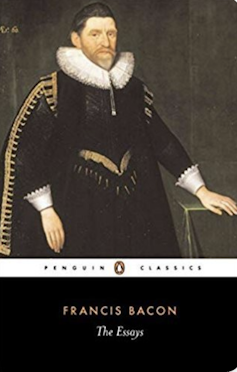Francis Bacon’s Essays explore the darker side of human nature. 400 years on, they still instruct and unnerve
- Written by Matthew Sharpe, Associate Professor in Philosophy, Australian Catholic University

In our guides to the classics, experts explain key literary works.
It’s 400 years since the publication of the complete edition of British philosopher Francis Bacon’s Essays. Not without pride, Bacon (1561-1626) muses in the preface that his little book’s Latin version might “last, as long as books last.” The Essays have, in fact, never been out of print since 1625.
His compatriate, poet laureate Ben Johnson, claimed Bacon’s writing represented “the mark and acme of our language.” Bacon’s Essays are indeed written with an ornamental grace. They brim with images and analogies more often associated with poetry than prose.
Almost every line reads like a quotable proverb. “Virtue is like a rich stone, best plain set”. “Suspicions amongst thoughts are like bats amongst birds, that ever fly by twilight”. “There is no excellent beauty that has not some strangeness in the proportion”.
A renaissance man, Bacon was the son of Queen Elizabeth’s Lord Chancellor. From early on, he was drawn into a political life at the court. He eventually rose to the Lord Chancellorship himself under King James, before falling from grace in disputed circumstances in 1621.
Yet Bacon was always ambivalent about his public calling. His letters attest that he felt himself better suited for the “contemplative” life of the mind.
He is best known today for his vital role in making the case for a new “advancement of learning” in early modern Europe. His 1620 work, Novum Organum, modelled a “new method” for studying nature, with rules for making structured observations, then tabulating and interpreting findings, which would inspire the later experimental sciences.
The Essays, in contrast, address social, moral and political subjects. They first appeared in 1597, (as a collection of just ten), expanding to an edition of 38 essays in 1612. Then, in 1625, the final edition of 58 essays was published. Bacon died the following year. Ever interested in the natural world, he caught a fatal chill while conducting experiments on the refrigeration of chickens in the snow.
What are the essays about?
Bacon’s Essays share their title with Michel de Montaigne’s earlier, much-loved book. Yet, they differ greatly from those of his French predecessor. Montaigne is warm, free-ranging and often playful. Readers feel like he is their friend. Bacon remains aloof, even grave, with only occasional flashes of wit.
Read more: Guide to the classics: Michel de Montaigne's Essays
What makes Bacon’s Essays so continually incisive is that, alongside Machiavelli (whom he admired), Bacon is among the first and most discerning authors to unsentimentally explore the darker sides of human nature.
His first essay, Of Truth, opens with a famous shot at the biblical Pontius Pilate, the Roman governor who gave the order for Jesus’s execution: “‘What is truth?’, said jesting Pilate, and would not stay for an answer …” Some authors, Bacon complains, “delight in giddiness, and count it a bondage to fix a belief”. They look more to fascinate and entertain, than to educate and inform. Bacon is no such “discoursing wit”. His Essays mean to get straight to the point.
Authors: Matthew Sharpe, Associate Professor in Philosophy, Australian Catholic University





